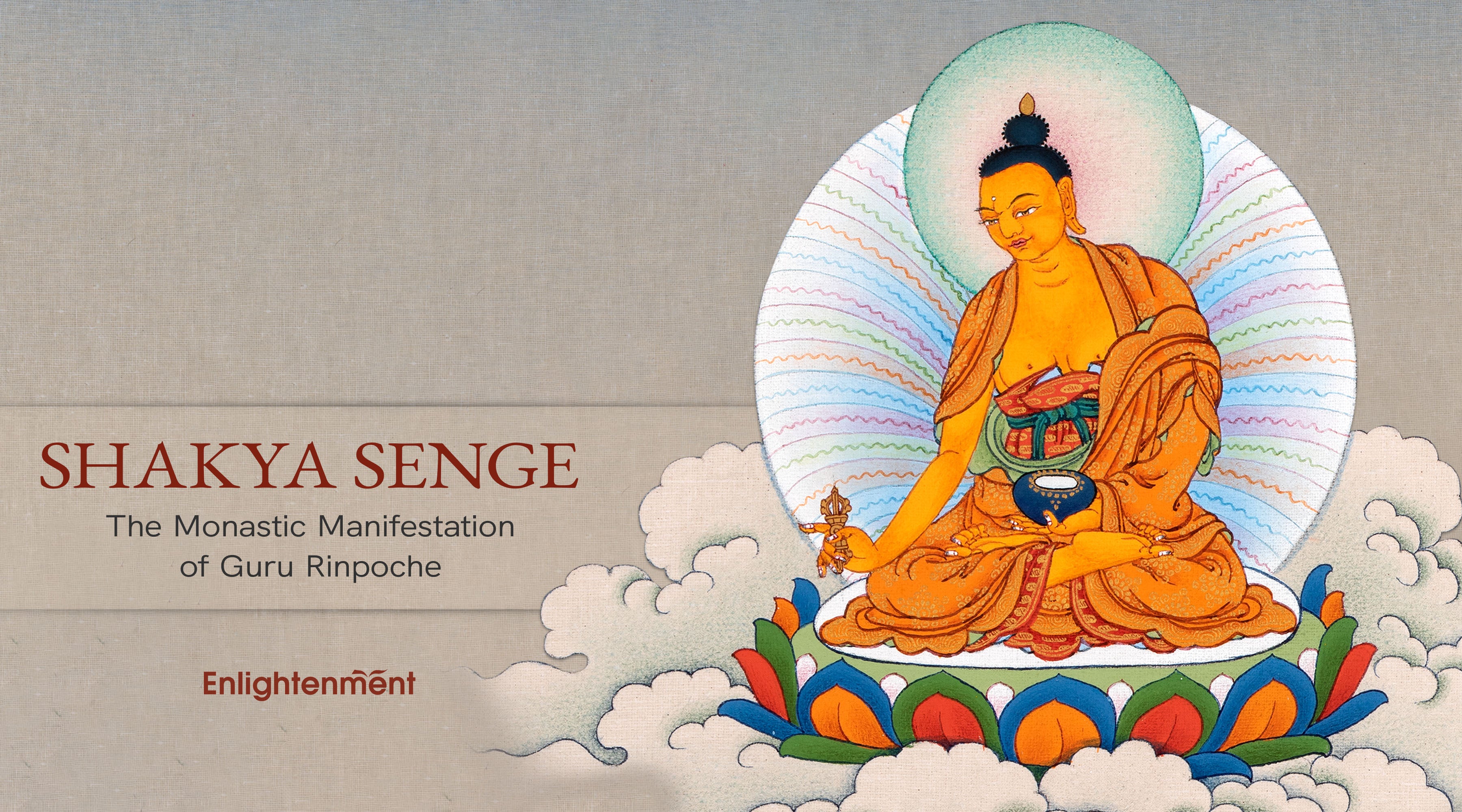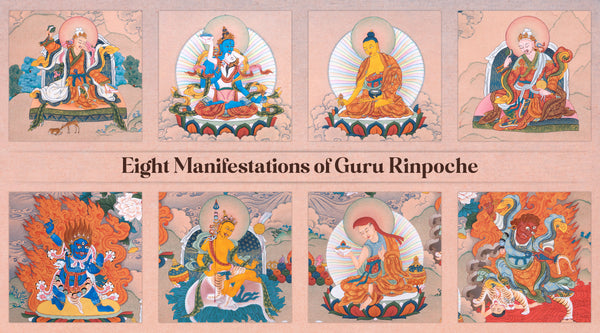The Monastic Form of Guru Rinpoche
Shakya Senge is one of the eight principal manifestations of Guru Rinpoche. The revered founder of Tibetan Buddhism embodied the eight forms time and again to guide and protect sentient beings in various ways.
Guru Rinpoche or Guru Padmasambhava was an enigmatic master revered for his wisdom, compassion, and miraculous abilities. He is credited with introducing Tantric Buddhism to Tibet in the 8th century .His teachings and legacy continue to be a profound influence on Tibetan Buddhism and its followers worldwide. Over time, he took on many forms to look after the Dharma followers and restore peace and Buddhism.

As each manifestation represents a specific path and aspect of Buddhism, each form allows devotees and practitioners to choose the one that resonates with them. Hence, each form embodies specific qualities or attributes. The eight manifestations of Guru Rinpoche are listed below:
- Shakya Senge
- Pema Gyalpo
- Nyima Odzer
- Dorje Drolo
- Senge Dradog
- Lodan Chokse
- Pema Jungne
- Urgyan Dorje Chang
Meanwhile, this particular form represents the monastic aspect of Guru Padmasambhava’s life and teachings. Known as the Lion of the Shakya clan, Shakya Senge is one of the crucial manifestations among others. This emanation depicts Guru Rinpoche as a fully ordained monk who led a spiritual discipline and lifestyle.
Origin of Shakya Senge: A Celestial Ordination Story
According to legend, Ananda, the revered brother of Lord Buddha, bestowed upon Guru Rinpoche the sacred status of a monk. This extraordinary event sent ripples of joy through the celestial realms. In celebration of this auspicious occasion, a bevy of delighted goddesses descended, bearing exquisite monk's robes as a gift for the newly ordained. Furthermore, a resplendent assembly of Bodhisattvas from every corner of the universe materialized in the heavens, their presence a testament to the significance of this moment.
As the ritual of hair cutting commenced, a peculiar occurrence unfolded. The simple task of severing the hair proved inexplicably difficult. Attributing this challenge to a dull blade, the individual entrusted with this duty sought to sharpen the instrument. Before he could complete this task, four celestial beings known as dakinis materialized, abruptly seizing the knife and hurling it into the heavens. With a resounding declaration, these divine entities asserted that such earthly customs were not binding upon Guru Padmasambhava. Undeterred by this celestial intervention, Guru Rinpoche proceeded with the monastic vows, his hair still flowing freely, yet his heart filled with unwavering faith and devotion. In recognition of this extraordinary event and as a mark of his new spiritual path, he was bestowed with the name Shakya Senge, or Lion of the Shakya Clan.
This captivating narrative serves as a powerful allegory, suggesting that the attainment of enlightenment is within reach for those who exhibit unwavering dedication to self-discipline and who willingly relinquish the allure of material possessions.
Shakya Senge Iconography
Shakya Senge is typically depicted in monastic robes in traditional Tibetan art. He holds an alms bowl in his left hand and the ritual thunderbolt, vajra in his right. This imagery portrays the combination of compassion and wisdom, which are the two core tenets of Buddhist practice. The two divine objects ultimately symbolize that the lion of the Shakya clan is not just a celestial being, he is also an idealistic monk.
The monk emanation is seated on the right side upon a moon disk of a lotus flower throne. He sits in the lotus position. The most noticeable piece in the Himalayan art is his hair that is piled into a bun. The bun is then adorned by a gem at the top. As a monk, he wears a simple attire embellished with gold patterns.
Thus, he is portrayed with a rich blue nimbus with golden rays, a proximity more astral than the other eight manifestations.

On his right side, a divine goddess is depicted presenting offerings collected from all living creatures. In the foreground, a graceful lotus flower adorned with auspicious symbols commands attention.
The Shakya Lion is encircled by four of his devoted followers, each engaged in the performance of miraculous feats. Beginning at the top and moving anti-clockwise, these disciples are identified as: one of the eight revered Rigzins; Mutri Tsenpo, portrayed as a highly enlightened being with regal attire; Yeshey Tsogyal, renowned for her ability to restore life to the deceased; Yudak Nyingpo, possessing immense power derived from profound spiritual insights; and Sharet Bhu Palsing, gifted with the extraordinary capacity to reverse the natural course of water.
The painting's landscape is characterized by an abundance and diversity of flowers, collectively evoking a sense of joy and optimism. Rocks and a rainbow strategically positioned on the horizon serve to distinguish the earthly realm from the celestial. The vibrant hues of the rainbow introduce a dynamic contrast to the solid colors of the surrounding landscape, enhancing its overall visual impact.
Significance of Shakya Senge
The lotus-born Guru Rinpoche is revered as both a tantric master and a yogi. Him in the form of Shakya Senge emphasizes the importance of monastic discipline and the gradual path to enlightenment, as outlined in the Sutrayana, the path of insight. This emanation illustrates the rigorous discipline of monastic life and how it is the fertile ground for the cultivation of Vajrayana insights.
Monastic purity: He perfectly demonstrates the path of a Buddhist monk as an ascetic manifestation. He follows the highest ethical standards and practices. He is an inspiring figure for those aspiring to lead a monastic life.
Bridging Sutra and Tantra: While Guru Rinpoche is primarily known for his Tantric teachings, Shakya Senge highlights the importance of the Sutra path as a foundation for the Tantric path.
Accessibility and Compassion: By appearing as a monk, Guru Rinpoche makes the teachings more accessible to a wider audience, including those who might be drawn to the monastic lifestyle or who find comfort in the traditional Buddhist teachings.
Demonstration of Buddhahood: Despite his monastic appearance, the revered monk is fully enlightened. He accentuates the potential for enlightenment within all living beings.
Shakya Senge: A Bridge Between Traditions
Shakya Senge serves as a bridge between the solitary, meditative practices of the yogis and the structured monastic life. Such unique circumstances of his ordination carved out the holy symbolism inherent in his name.
The most significant part of his background is how the dakinis refused to allow the traditional hair-cutting ceremony and broke free from the conventional. Thus, his new monk name left behind another symbolism:
Lion: signifies courage, wisdom, and leadershi. As the lion is a potent symbol in both Buddhist and indigenous Tibetan cultures, it represents the capacity to overcome obstacles and illuminate the path for others.
Shakya: Refers to the lineage of Buddha. This component of the name anchors Senge to the Himalayan Buddhist tradition.
That being the case, Shakya Senge embodies the synthesis of different spiritual paths. His story and name exemplify the idea that while traditions provide a foundation, true spiritual growth often involves transcending these boundaries and forging new connections. This makes him a potent symbol of unity and inclusivity in the broader context of Tibetan Buddhism and its relationship with other spiritual traditions.This manifestation underscores the idea that both paths can lead to the same ultimate goal: enlightenment.


